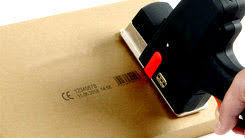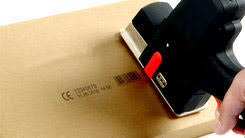
The world's most secure marking system is being claimed to have been developed by researchers at the University of Copenhagen. This system would be able to fight against pirated goods – ranging from pirated pharmaceuticals, foodstuffs, designer merchandise and artwork.
And since the markings are random and they cannot be hacked, therefore the new system can be launched in the market within a year. The development has been published in Science Advances, a scientific journal.
Counterfeited goods made by pirate manufacturers are a source of suffering for companies around the world on a regular basis. Such companies also are not much concerned about international patents. Moreover, the pirate manufacturers also sometimes place lives of people at risk by manufacturing and selling counterfeit medicines.
But in terms of addressing the problem of all forms of pirate manufacturing, the system of coding developed by four researchers from the University of Copenhagen's Nano Science Center is the "the safest in the world" according to the head of research and associate professor Thomas Just Sørensen of the University of Copenhagen's Department of Chemistry.
"The system, which deploys three rare earths among other things, is based on randomness, which makes it unable to be hacked or tampered with," says Sørensen.
"As soon as a customer asks that an authorized dealer checks up on a piece of merchandise that was meant to be marked using the system, an expensive wrist watch for example, the dealer can access a manufacturer database to check its authenticity."
Sørensen explains that there is miniscule chance of two products possessing the same digital 'fingerprints' or digital key. "It corresponds to a one out of an enormous number composed of a 6 followed by 104 zeros."
A patent has been taken out by the University of Copenhagen for this new system and authorities expect that it would be around a year that the system can be launched in the market. at the present moment, last stage work on scanning solutions are being conducted so that they are made ready for manufacturers.
According to Thomas Just Sørensen: "We estimate that it will take approximately one year, at which point we will be very close to being able to put a commercial version on the market."
While some of the costs of implementing the data-system are yet to be finalized, the researchers believe that not more than one Danish krone would be expended for marking products.
But how are the marking codes based on randomness created?
The researchers added europium, terbium and dysprosium – three rare earth metals – one each into three small tubs of sand. When placed against a specific wavelength of light, each of the rare earth metals lights up. An appropriate dosing of a single rare earth gets absorbed into the surface of each grain of sand. The three sand buckets are then thoroughly mixed followed by the process of marking.
A product is attached with thousands of coloured grains of sand on a tape. There are a number of ways that a unique pattern can be created with the use of the coloured grains of sand. Leather can be inserted with these patterns and so can glass and metal. The patterns cannot be rearranged into another puzzle because the grains of sand are very small and hence cannot be individually removed.
When the patterns are exposed to three specific wavelengths of light, the individual europium, terbium and dysprosium coated sand particles light up into three pictures. A single image is created by combining the three pictures. The researchers claim that since it is nearly impossible to replicate the unique patterns in which the sand grains are placed, therefore, chances of duplicating the marking is near to zero.
(Souorce:www.sciencedaily.com)
And since the markings are random and they cannot be hacked, therefore the new system can be launched in the market within a year. The development has been published in Science Advances, a scientific journal.
Counterfeited goods made by pirate manufacturers are a source of suffering for companies around the world on a regular basis. Such companies also are not much concerned about international patents. Moreover, the pirate manufacturers also sometimes place lives of people at risk by manufacturing and selling counterfeit medicines.
But in terms of addressing the problem of all forms of pirate manufacturing, the system of coding developed by four researchers from the University of Copenhagen's Nano Science Center is the "the safest in the world" according to the head of research and associate professor Thomas Just Sørensen of the University of Copenhagen's Department of Chemistry.
"The system, which deploys three rare earths among other things, is based on randomness, which makes it unable to be hacked or tampered with," says Sørensen.
"As soon as a customer asks that an authorized dealer checks up on a piece of merchandise that was meant to be marked using the system, an expensive wrist watch for example, the dealer can access a manufacturer database to check its authenticity."
Sørensen explains that there is miniscule chance of two products possessing the same digital 'fingerprints' or digital key. "It corresponds to a one out of an enormous number composed of a 6 followed by 104 zeros."
A patent has been taken out by the University of Copenhagen for this new system and authorities expect that it would be around a year that the system can be launched in the market. at the present moment, last stage work on scanning solutions are being conducted so that they are made ready for manufacturers.
According to Thomas Just Sørensen: "We estimate that it will take approximately one year, at which point we will be very close to being able to put a commercial version on the market."
While some of the costs of implementing the data-system are yet to be finalized, the researchers believe that not more than one Danish krone would be expended for marking products.
But how are the marking codes based on randomness created?
The researchers added europium, terbium and dysprosium – three rare earth metals – one each into three small tubs of sand. When placed against a specific wavelength of light, each of the rare earth metals lights up. An appropriate dosing of a single rare earth gets absorbed into the surface of each grain of sand. The three sand buckets are then thoroughly mixed followed by the process of marking.
A product is attached with thousands of coloured grains of sand on a tape. There are a number of ways that a unique pattern can be created with the use of the coloured grains of sand. Leather can be inserted with these patterns and so can glass and metal. The patterns cannot be rearranged into another puzzle because the grains of sand are very small and hence cannot be individually removed.
When the patterns are exposed to three specific wavelengths of light, the individual europium, terbium and dysprosium coated sand particles light up into three pictures. A single image is created by combining the three pictures. The researchers claim that since it is nearly impossible to replicate the unique patterns in which the sand grains are placed, therefore, chances of duplicating the marking is near to zero.
(Souorce:www.sciencedaily.com)














